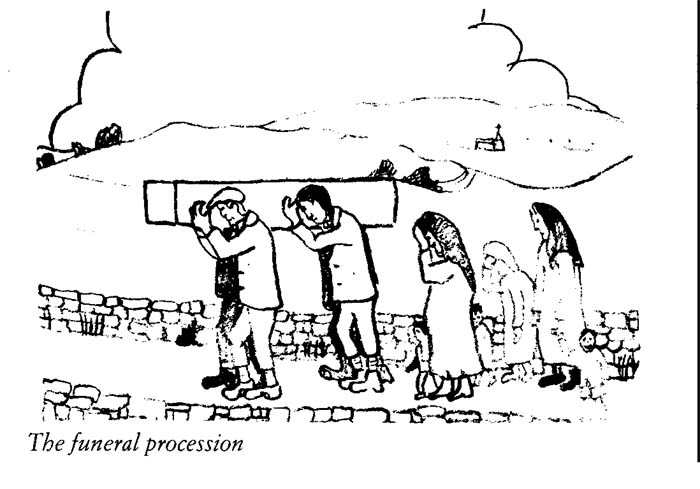
There are traditions and stories attached to different areas throughout Ireland, and Cuilmore and the surrounding areas are no exception. The stories attached to this area are not forgotten. Traditions such as St. Johns night, Halloween and April Fools Fay are still carried on, but some of the older traditions are sadly dying away.
WAKES
It is not known where the custom of the wake started since the 18th century insofar that they bury the body within two days of the death. Once upon a time they kept the body in the house for three days. It is believed that "The Banshee" was heard three nights before a death.
The description of a banshee was that of a long haired woman usually seen at a river combing her hair and wailing. Anyone who saw or heard this woman knew that there was going to be a death. The first thing they did when the person departed this life was to cover all the mirrors in the house. The reason for this is not known but it was thought to bring good luck to the house. The body was left for three hours before it was washed and coins were used to cover the eyes. The body in the case of a man was cleaned by the woman of the house and always shaven by a man. Clean sheets or a bed of straw was prepared to put the body overboard.
As the night went on, tea and sandwiches were served and a clay pipe given to men, women and children. On receiving a clay pipe one would bless himself. This brought luck. People waited all night with the body as a mark of respect and it was a way of comforting the bereaved in their hour of need. Stores and card games were played and at twelve o'clock the rosary was recited by a neighbour or priest. When the coffin came it was placed on foul chairs usually turned the opposite way the day of removal. Holy water was thrown on a roof of thatch. The holy water used outside was never taken inside the house.

THE FUNERAL
The coffin was taken to the church by a horse drawn cart depending on the financial status of the people concerned: If they could not afford this, it was carried on two sticks called Maide Crocher. The coffin was carried by brothers or relatives, but in the case of a woman it was carried by four men of the same maiden name.
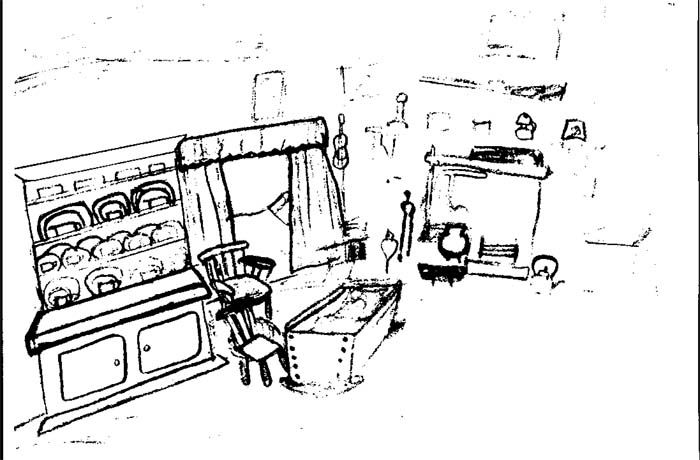
THE KITCHEN
The kitchen and the hearth are the very core of the Irish house and the turf burning continuously day and night throughout the year, is the symbol of family continuity and of hospitality towards the stranger. When it goes out, it has been said, the soul goes out of the people of the house. The fire serves not only to prepare food and dry clothes, to bring warmth and comfort to the family and to animals who were hurt, but also to keep the thatch dry and preserve the roof timbers. For the housewife, her last duty on the night was to "smoor it" or take it, burying a line of turf in the ashes to retain a spark which can be fanned into a blaze the next morning. The iron crane with a long arm pivoting on heel is characteristic of stone' fireplaces. Made to hang the mighty iron post on, some with a capacity of twenty five gallons, to hold food for man and animal, the adjustable pot-hanger which hooked onto the arm of the crane is a simple but effective device for adjusting the height of the hanging pot. Over the hearth, in many cases was a shelf which had ~ display, a pair of brass candlesticks, china dogs, a crucifix or a religious picture in front of which a little red lamp always burned, in some houses a large rosary beads hung on a peg near the hearth,
In the old kitchens years ago, there was a hag bed or as it is more commonly known to us as chailleach.
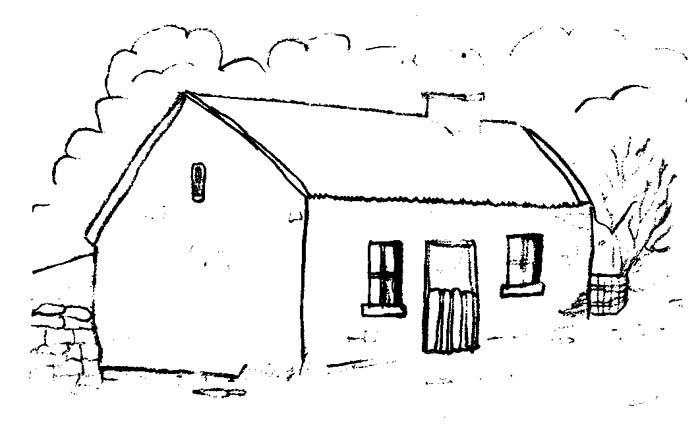
THE THATCHED COTTAGE
The most widely distributed mode of thatching is by means of scollops or sally rods which pin down the thatch. In well-finished work the rods were hidden for if exposed they tend to let water seep through the straw. There are various ways of pushing in the scallops. They may be thrust in at each end or bent into wooden staples resembling large hairpins which secure the ends of horizontal rods. The scallops thatch is perhaps best suited to, and is almost always on, roofs which are hipped. Over the timbers in all houses are places stripes of scraws which serve both as insulation and as a base on which the straw could be secured. The outer covering was normally of wheaten or barley straw. To secure the thatch mud was also used. Materials needed were obtained locally and roofs were usually built by the occupiers.
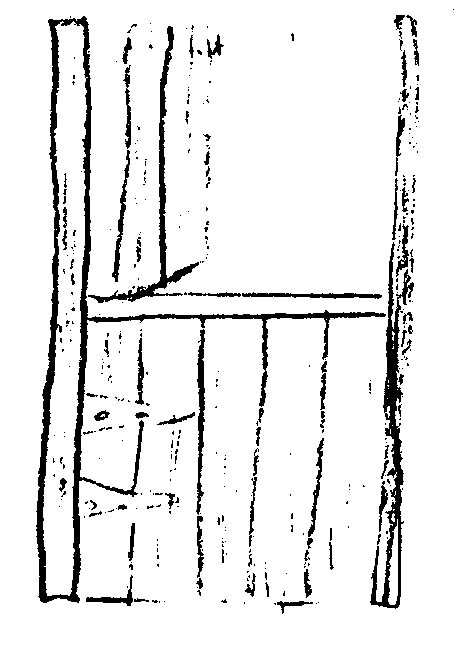
THE HALF DOOR
The half door of the cottage, generally painted red or green, had several functions. It kept children in and at the same time kept unwanted and unwelcomed animals out. It allowed fresh air and daylight to enter as well as providing a suitable armrest whilst contemplating or chatting to passersby. It is said that a man standing at the door would be wasting time but a man leaning on the half-doors would be passing time.
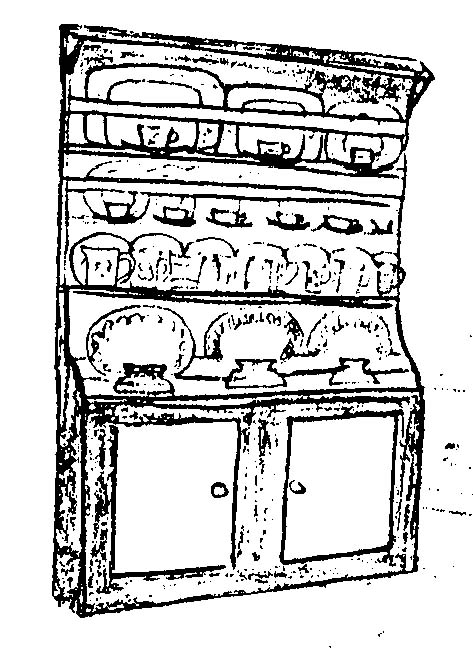
THE DRESSER
The dresser was a main feature of most farm house kitchens. The housewife's pride and joy. The dresser was where she displayed her delph, perhaps the willow pattern, which was and is well known, also crockery and all housewives at that time had the range of jugs which were eye-catching and ornaments, some may be given to her by relatives and friends. Some houses today have the dresser with the willow pattern on display.
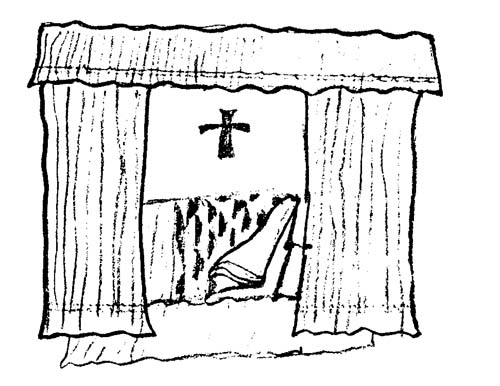
THE HAG BED -AN CHAILLEACH
The chailleach was common in Cuilrnore and the surrounding areas. It was formed by projecting a section of the side wall of the house near the hearth. This was closed by a curtain and contained a bed which was favoured by grandparents who might have been bedridden. This arrangement proved beneficial in that the senior members of the family continued to play an important role in the social and domestic pattern of the household. They were always made feel loved. Their advice, and skills were invaluable, and they generally possessed a wealth of storytelling, an art today which is sadly disappearing.
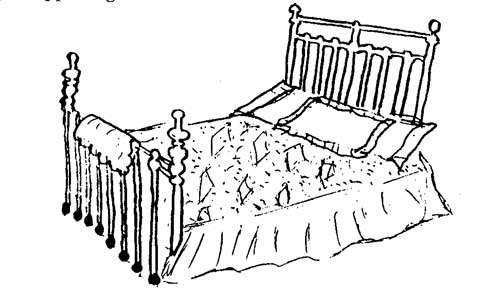
THE BEDROOM
The bedroom was simply furnished, and it was dominated by a large bed with iron bedstead and brass fittings. The quilt or bedspreads were often showpieces, which were either knitted or different coloured patches sown by hand known as patchwork.
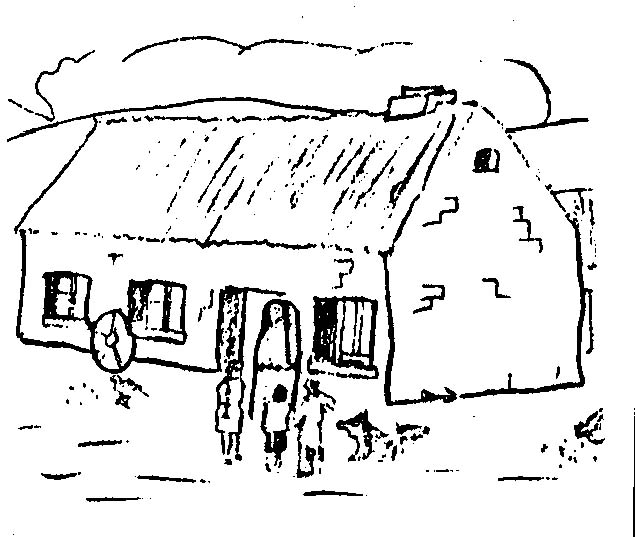
ST. STEPHENS DA Y
On Saint Stephen's Day people went out with the , wren if they could catch it and sing and dance –the less fortunate people carried a crannog, This was four sticks nailed together in the shape of a Christmas tree. Today, children recite the wren, say poems and sing and dance. They dress up with unusual clothes and false-faces.
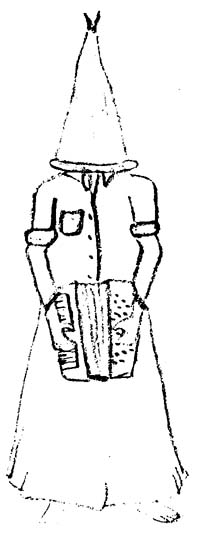
THE STRAWBOYS
The strawboys are usually seen at weddings. They were dressed up in straw hats, white shirts and skirts. The face was covered so that no one would know them. They were uninvited guests. The group consists of eight people -a captain who gives the orders, an old man and an old woman also known as the Caileach and the Sheanthine, a musician and four dancers who would do a half set. The old man and old woman performed the Stack of Barley. This tradition is still carried on today, either a relative or close friend invite the strawboys. It is a lovely tradition and hope it always continues.
WEATHERLORE
Signs of rain: In days of long ago, people knew by the various signs how the weather was going to be. The signs of rain were many.
1. A circle around the moon.
2. The sun creeping in around an embankment of clouds in evening.
3. A rainbow in the morning.
4. South east winds.
5. Seagulls coming inland.
6. Swallows flying low.
Signs of Storm:
1. Cat purring at the fire or sharpening his nails on a tree.
2. Seagulls (blackheads) coming inland.
3. Seals coming to the surface of the sea.
Signs of Good Weather:
1. Red sky at night.
2. Green hills far away.
Signs of Frost and Snow
1. A black, dark sky.
2. A dark sky with virtually no stars in it at all.
OLD PISHROGUES PASSED DOWN THROUGH THE GENERATIONS
LUCKY
1. It was lucky to meet a black cat at night.
2. It was considered to be lucky for a person going on a long journey to meet a man.
3. When a couple got married, they would tie shoes and tin cans onto the side cart for good luck. Today, this tradition is ! kept alive by throwing confetti on the couple as they leave, and by decorating the car with lipstick and aftershave. People also tie old shoes and tin cans on the car for good luck.
4. When a person found a horse shoe it was considered lucky when hung over a door.
5. When poteen was made, they would throw the first drop over their shoulders for the fairies.
6. When there was a churning to be made, they put a burnt coal under the chum for good luck.
7. On bonfire night they would throw a coal into the potato field for a good crop.
8. For a first visit to a house people would bring a cup and saucer or sods of turf, this tradition was to bring the couple good luck.
9. To meet a red haired woman while going to the fair was considered to be unlucky. It meant that one would have to sell the animal no matter how low the price, and some people were so superstitious, they would go home again, rather than go to the fair.
10. To see one magpie on its own was a sign of sorrow or bad luck.
11. It was unlucky to see a weasel or to see a hare crossing the road while going on a long journey. This meant one had to return and start out on the same journey again.
12. A robin entering the house was a sign of death.
13. The number 13 is considered to be an unlucky number, unless you were born on the thirteenth day. In particular, people are very suspicious of Friday 13th.
14. It is unlucky to open an umbrella indoors and people generally walk around a ladder rather than underneath one.
15. If a cat is washing his face, the first one he looks at after he has finished, will be the first one to die.
16. If you see a cat rubbing his ears, it is a sign of bad weather.
17. Years ago when a baby was born, mothers could not do any work or wash their hands in water until they were churched.
18. To warm the Guinness in the olden days, the publican would heat the porter in the fire.
19. When a person died, they would hold a wake. The family would buy chalk pipes and fill them with tobacco and any pipes left over were kept for the next funeral.
20. At the dances men were on one side of the hall and the women on the other.
21. When a woman got married, she would receive a dowry and if after a month, the money had not come, the husband would send her home.
22. If you spilled salt or broke a salt-cellar, it was considered to be unlucky.
23. If a family member died, the family would not socialize for a year afterwards.
24. In the olden days it was considered bad luck to give milk without putting three drops of water in it.
25. If a family member was going across the water, the parents would throw the tongs after them. This was believed to bring the person good luck.
26. Halloween -I would like to finish off by writing a little on halloween. On All Souls Night, the door was left open and a bed of straw left out beside the fireplace. They believed that the dead arose on that night. The doors of the houses were left open. This signified that the soul was wdcome. That night people would dress up and they would go from house to house entertaining people, doing mischievous things such as throwing heads of cabbage. Cakes were made, one with a ring, pea and a rag. Whoever got the ring would be married before the year was out and whoever got the pea would not get married at all, and whoever got the rag would be as poor as could be. In the olden days our ancestors believed in pishrogues and traditions that were passed down through the generations. Nowadays, people do not believe, but they like to keep some customs alive.
CHURNS
Most houses had a churn which was the vessel used to make butter. Churns came in a variety of sizes and styles.
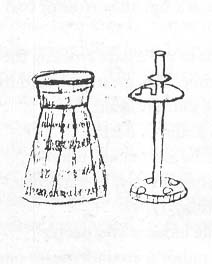 |
Dash Churns: This was the common type of churn which was of stoutly built stave vessel more or less conical in shape with a splayed neck into which the lid fitted. The cream was .agitated by a wooden dash provided with a long handle which passed through a hole in the centre of the lid. When churning was taking place in an Irish farmhouse, it was considered unlucky for anyone who entered the house not to turn the handle of the churn.
|
| Cylindrical Churns: In this type of smaller churn, the milk was agitated by a wooden frame with a crank handle and it became popular in the present century. This form of churn had a limited capacity and was therefore owned by small farmers who did not require a lot of butter from a single churning. | 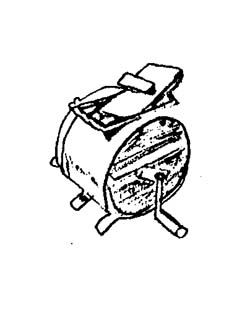 |
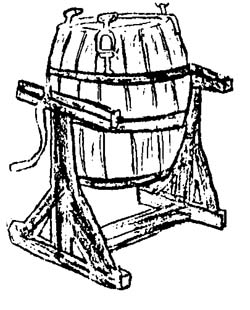 |
Tumble Churns: The tumble churns were smaller barrel churns which rotated on the axis of the barrel and were sometimes known as end-over-end churns or twist churns. This was a popular churn in medium size dairies. The cylindrical churn and the dash churns were the most popular churns in the Cuilmore and surrounding areas. |
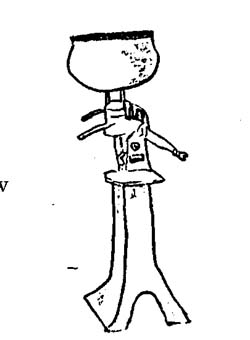
MILK SEPARATOR
In the making of butter, milk had to be three days old before churning. The cream was skimmed off, put into another container, covered with muslim and left to mature. The remaining milk was skimmed milk. By the end of the nineteenth century, most dairies possessed a separator which was a great time-saver as the overnight maturing of the milk was now eliminated. A centrifugal force inside the machine separated the cream from the skimmed milk so that they poured out through separate channels.
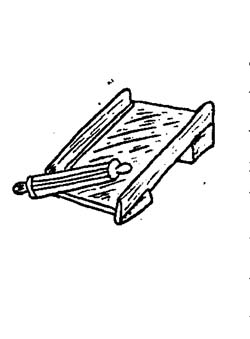
BUTTER MAKER AND ROLLER
The thick butter from the churn had to be washed several times in clear, cold water before moulding. The butter maker and roller was a device which took the drudgery out of the washing process. The groved surface of the roller enabled the surplus buttermilk to be drained away through a small hole in the corner.
CROCKS
After milking the milk was poured from the milking pail into a large earthenware container called a crock. This cooled the liquid. Before it could be churned it was left for three days when the cream was then skimmed from the top and poured into a second container. This was covered with muslin and left to 'ripen'. The remaining milk in the crock was now skimmed milk. Once the butter was clean, butter-pats were used to mould it into round shape, butter-balls or welges, on to which an emblem could be imprinted with a special stamp but very few had the butter stamps in this area.
Butter Dish |
Pats or Spades |
Butter stamps |
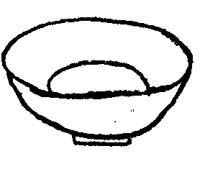 |
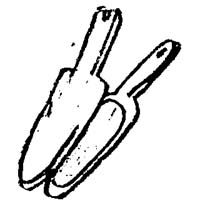 |
 |
THE SPINNING WHEEL, THE FLAX WHEEL AND THE CARDERS
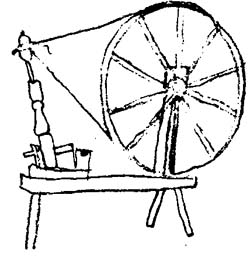
THE BIG SPINNING WHEEL
The tuirne was the big spinning wheel, or wool spinner. It consisted of a large wheel on a simple platform with the spindle works positioned at one end, directly opposite the wheel. In some areas the platform was low so the spinner could sit while working. The function of the spinning wheel was to make woollen thread initially the wheel was carded into long fragments and a strong, slight thread was made from them with the help of the spindle.
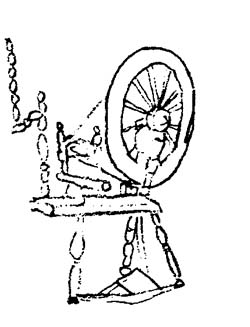
THE FLAX WHEEL
The flax wheel gradually replaced the big wool spinning wheel and was much used in Mayo and other counties also, where it was originally introduced to spin flax and produce thread for the linen trade. Twisting and winding-on remained two separate operations until the introduction of the U-flier and treadle meant even more improvement because the spinner's hands were free to work the wool at all times. By re-spinning she could produce wool suitable for heavy garments.
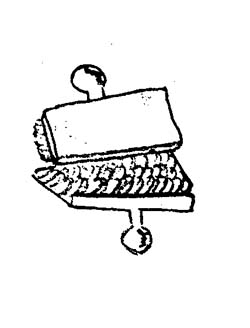
CARDERS
The carding boards had rows of small curved wire teeth which opened and straightened the fibres of the wool by brushing between the boards. The fibres were the fluffed up and made to lie in one direction only, and were finally rolled by hand or by the smooth parts of the board into tub-like shape called a rolag. The wool as then ready for spinning-wheel.